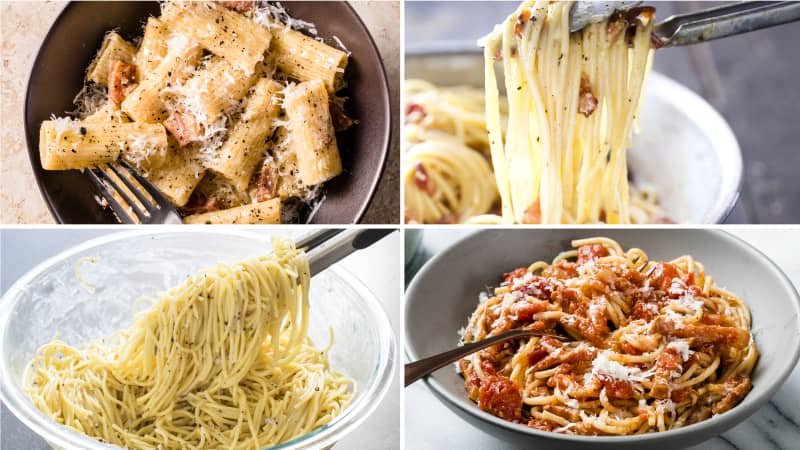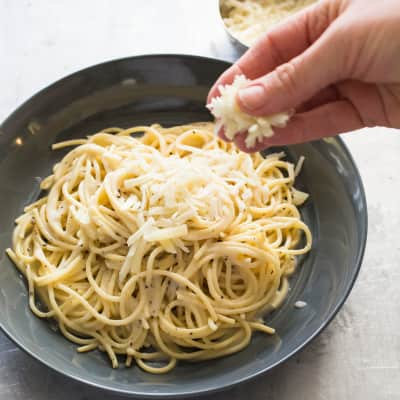Italians (myself included) are passionate people, especially when it comes to food. We love to talk, and tell stories, and argue about various dishes—where exactly they come from and how they should be made. “Myths about food and recipes are part of Italian culture, a way of fondly expressing pride in a rich gastronomic heritage,” writes Gillian Riley in the Oxford Companion to Italian Food. In Rome, these discussions often revolve around pasta, particular the city’s four classics: Cacio e Pepe, Gricia, Amatriciana, and Carbonara.
Rome's 4 Classic Pastas
Published Oct. 19, 2018.

While each dish is distinct, they are all variations on a minimalist theme: pasta seasoned with salty, tangy Pecorino Romano; black pepper; and in most cases the rich, deeply savory cured hog jowls known as guanciale. Gricia is pork-forward; the noodles are punctuated with chewy bits of meat and glossed with its savory fat, as well as the pepper and cheese. Carbonara adds an egg, which makes the “sauce” creamy, while amatriciana loses the egg and adds tomatoes, their acidity balancing the richness of the pork and cheese. And cacio e pepe keeps it simplest of all with just cheese and pepper.
Back to the storytelling: Here are some of the toothsome tales surrounding Rome’s famous pasta quartet.
Cacio e Pepe

Food historians continue to speculate about the true origin of this dish. From the 13th-century Italian cooking tome Liber de Coquina, a recipe called "de lasanis" calls for cut-up lasagna sheets, made from fermented dough, to be cooked in water and tossed with grated cheese. Similarly, Johann Wolfgang von Goethe published an account of his travels in Italy in the late 1700s, in which he writes of the pasta he encountered that was also dressed in cheese.
A counterargument from Katie Parla, author of Tasting Rome, states that “cacio e pepe is a relative newcomer to the Roman repertoire, first appearing in the mid-twentieth century.” Other accounts suggest that cacio e pepe has long been a Roman favorite that’s simply flown under the radar.
Perhaps because it is so simple, the dish was rarely found on trattoria menus until quite recently. Media outlets declared it Rome’s “trendiest pasta dish” in 2012, and New York’s “trendiest dish of 2016.” Thrust into the spotlight, the simplicity of the dish has proven to be timeless.
Our Take
Pecorino, an aged cheese that is salty, tangy, and rich, tastes great, but clumps because its lipoproteins (molecules that keep fats and proteins from separating) break down as the cheese ages. Here’s how we made a smoother sauce.
- Cook the pasta in less water: Doing so results in cooking water with lots of starch, which, when stirred into the cheese, helps prevent it from clumping.
- Add a little cream: Fresh dairy contains lipoproteins that help prevent the Pecorino from clumping.
Spaghetti with Pecorino Romano and Black Pepper (Cacio e Pepe)
With just three main ingredients (cheese, pepper, and pasta), this Roman dish would be the best quick meal we ever tasted. As long as we could keep the sauce from clumping.Pasta alla Gricia

Rome’s sleeper hit, Pasta alla gricia, has been around for centuries and accumulated numerous origin stories. Some sources say it hails from “Grisciano”, a small town close to Amatrice, which closely resembles the dish’s name. A broader theory credits shepherds arriving from the Apennines with inventing the sauce, as it was made with cheese and cured meat that they could carry around in their packs for days at a time. Others point to the word gricio, an early Roman term for bread-maker, or a seller of bread and other staples such as meats and cheeses, many of whom were immigrants from the alpine Canton of Grisons in Switzerland that had moved to the area. And some claim it simply as a mispronunciation of the word grigia (“gray”), referring to the fact that the tomato-less sauce looks rather drab. (Gricia is also widely considered to be an ancestor of the more famous amatriciana, and often called “white amatriciana.”)
Our Take
Rendered pork fat makes the dish deeply savory and rich, but often greasy, too. Here’s how we kept the sauce creamy and emulsified.
- Boil measured amounts of fat and pasta water: Measuring each component ensures consistent results.
- Boiling the liquid also helps break up the fat droplets to create a thick, cohesive sauce.
Pasta alla Gricia (Rigatoni with Pancetta and Pecorino Romano)
The porky-peppery flavors of pasta alla gricia deserve big recognition.Amatriciana

The first known written recipe of tomato sauce for pasta appears in the Italian cookbook L’Apicio moderno (The Modern Apicius) from 1790, by Roman chef Francesco Leonardi. When and where tomatoes were added to amatriciana, however, is unclear. Some sources say as early as the end of the 18th century; others claim tomatoes were a much later addition, even as recently as after World War II, and may have first been added in Rome. In their book, Pasta the Italian Way, food historian Oretta Zanini De Vita and Maureen Fant note that because tomatoes don’t grow well around Amatrice, they were probably canned.
Despite being considered a Roman pasta, amatriciana (like gricia) carries the name of a village located outside the city. Located in northern Lazio region, the town of Amatrice is where most say that Amatriciana was created and brought to Rome when, to escape the Apennines during winter, Amatrice shepherds came to sell their regional products. (The dish also goes by the spelling “matriciana” in Rome. Some say this refers to the word matrice, which is the brand, or identification number that was pressed into the guanciale.)
No matter where it originated, the residents of Amatrice are protective of the dish, which is ingrained in the town’s heritage and legacy. For example: In 2015, local officials publicly denounced one of Italy’s most famous chefs, Carlo Cracco, after he revealed on national television that his secret “amatriciana” ingredient was sautéed garlic.
Our Take
Tomatoes, not pork, are the prominent flavor in this dish. But the pork and its fat play crucial roles in flavor and sauce consistency.
- Cook pork in water: Simmering salt pork (our alternative to harder-to-find guanciale) in water tenderizes the meat, and renders its fat so that the meaty pieces can quickly brown once the water evaporates.
- Add rendered pork fat to Pecorino: Mixing the aged cheese with cooled rendered pork fat prevents it from clumping and ensures porky flavor in each bite.
Pasta All'Amatriciana
To perfect this controversial Italian dish, we looked to a staple of the American larder.Carbonara

Despite its iconic status, Carbonara is relatively young—a mid-twentieth century invention that doesn’t appear widely in print until after World War II. And legends surrounding the dish’s name and origins are highly controversial.
It might have been the invention of Italian coal workers, or carbonari (the Italian word for charcoal is carbone) or miners, who would make the dish on their shovels over fires. Or “carbonara” might simply reference the ground black pepper that resembles flecks of coal. (The term "coal miner's spaghetti" is still used to refer to carbonara in parts of the United States.) There are also myths about a 19th-century secret Neapolitan political society called “carbonari”; American World War II soldiers' who turned their bacon and egg rations into a pasta dish to quell their cravings for the flavors of home; and post-war military rations of powdered egg and bacon being used to season pasta. But there’s little hard evidence to support most of these stories.
Our Take
Eggs, cheese, and pork tend to add up to a dish that’s too rich to enjoy, so we cut back on the fat while keeping the sauce silky and flavorful.
- Cook pasta in less water: As in Cacio e Pepe, we reduce the amount of cooking water to create a super-starchy base for the sauce that creates viscosity and prevents the eggs from curdling and the aged cheese from clumping.
- Use whole eggs, not just yolks: Egg yolks introduce a pleasant custardy richness, but they also have a powerful emulsion and thickening capability that can turn the sauce into glue just minutes after serving if too many are used. Three egg whites and four yolks gave us a sauce with the custard flavor that we were after and an ideal thickness that did not change significantly as it cooled during a 15-minute serving window.
- Warm the serving bowl: Mixing the spaghetti with the sauce in a warm bowl rather than a hot skillet or pot allows the residual heat of the pasta to “cook” the sauce without any chance of overcooking the eggs.




